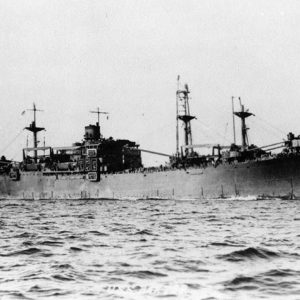calsfoundation@cals.org
USS Baxter (APA-94)
The USS Baxter was a Sumter-class attack transport ship that saw action during World War II. It is named in honor of Baxter County.
The Baxter was the fourth and final ship in the Sumter class to be constructed, with work beginning on March 18, 1943, in Chickasaw, Alabama; the other three ships of the class were constructed in 1942. The ship was launched on September 19, 1943, and was acquired by the U.S. Navy on November 30, receiving a reduced commission. The Baxter sailed to Brooklyn, New York, where it arrived on December 14. Work to convert it to an attack transport began the same day. The ship was fully commissioned on May 15, 1944, under the command of Captain Calvin Sinclair.
The Baxter and other ships of the Sumter class were designed to transport troops to offshore locations near invasion beaches where smaller craft would be used to land the men and equipment. In order to protect the troops disembarking from the ship during combat, the Baxter was heavily armed. The ship had two five-inch guns in dual-purpose mounts, as well as four forty-millimeter and ten twenty-millimeter anti-aircraft guns. This gave the ship protection against both sea- and air-based attacks.
The crew of the ship consisted of fifty-six officers and 498 enlisted men, while it could transport ninety-five officers and 1,422 enlisted men to the combat zone. The ship was more than 468 feet long and sixty-three feet wide and had a top speed of 16.5 knots.
The Baxter underwent a “shakedown” cruise (a test or trial cruise) on Chesapeake Bay and arrived at Norfolk, Virginia, on June 9, 1944. The Sixty-first Replacement Battalion of the U.S. Marine Corps boarded the ship, which departed on June 20. Along with a destroyer and destroyer escort, the Baxter transited the Panama Canal and proceeded to Pearl Harbor, Hawaii, arriving on July 11. After disembarking the troops, the Baxter returned to San Diego, California, to transport another unit. Steaming to Hilo, Hawaii, the Baxter completed another round trip between San Diego and Hilo before returning to Pearl Harbor.
The Baxter was assigned to Transport Division 10, and the unit practiced for an invasion of Yap in the Caroline Islands. On September 15, 1944, Transport Division 10 joined Task Group 33.2 and departed Hawaii for Yap. In route to the objective, the capture of Yap was canceled, and the Task Group was diverted to Manus in the Admiralty Islands. Leyte in the Philippine Islands was assigned as the target of the Task Group, and the Baxter arrived off Dulag on October 20, 1944. Over the next four days, the ship disembarked men and equipment before moving to Hollandia, New Guinea, and Biak, Schouten Islands, where the headquarters command of the Fifth Air Force boarded the ship. Attacked by Japanese aircraft on November 18, the Baxter did not suffer any damage or casualties, and unloaded the men and equipment at Leyte. The Baxter unloaded additional units belonging to the Fortieth Division of the U.S. Army before returning to Manus on December 11.
On December 31, 1944, the Baxter departed the Admiralty Islands for the Philippines again. The Task Group that the Baxter belonged to was attacked by kamikaze planes on January 8, 1945, and the USS Kitkun Bay was struck. The Baxter was not hit, going on to participate in the invasion of Luzon in late January. The ship next saw action during the invasion of Okinawa. Landing troops on April 1, 1945, the Baxter served as a prisoner-of-war ship for several days.
The Baxter next moved to Saipan and Pearl Harbor before returning to San Francisco, California, where some naval construction engineers were transported to Pearl Harbor. On June 1, 1945, the Baxter departed Pearl Harbor as the escort of the USS Pinkney, which was severely damaged in a kamikaze attack off Okinawa. The ships arrived in California, and the Baxter made several more trips between the West Coast and the South Pacific during the summer.
With the surrender of Japan, the Baxter transported more than 6,000 troops back to the United States during three round trips. The Baxter arrived in San Diego on February 10, 1946, at the conclusion of its last trip. Moving to Mobile, Alabama, the ship was decommissioned on March 22, 1946, and was sold to the Waterman Steamship Corporation. Renamed the La Salle, the ship was eventually scrapped in 1968. The Baxter earned four battle stars for service during the war and is the only ship to be named for Baxter County.
For additional information:
Dictionary of American Naval Fighting Ships. Vol. 1. Washington DC: Navy Department, Office of the Chief of Naval Operations, Naval History Division, 1959.
David Sesser
Henderson State University
 Military
Military World War II through the Faubus Era, 1941 through 1967
World War II through the Faubus Era, 1941 through 1967 SS La Salle
SS La Salle  USS Baxter
USS Baxter  USS Baxter; 1946
USS Baxter; 1946 




Comments
No comments on this entry yet.